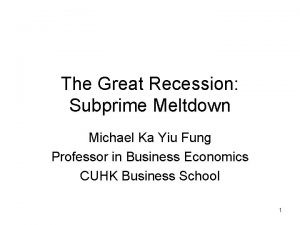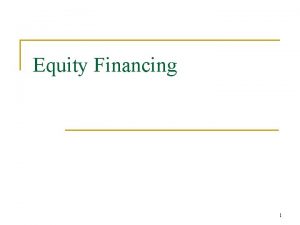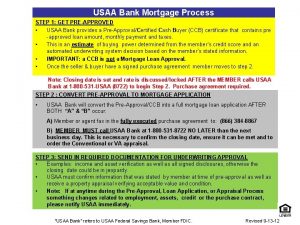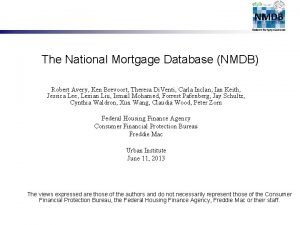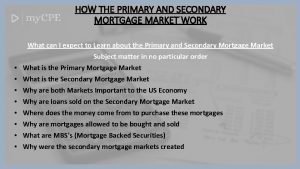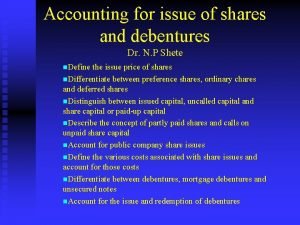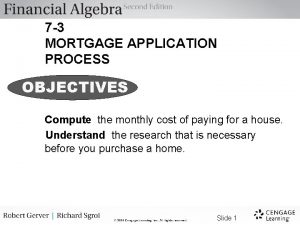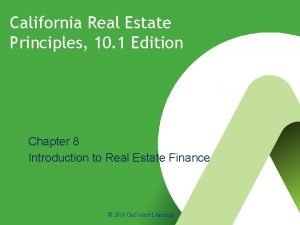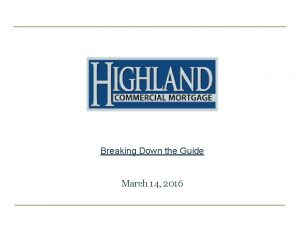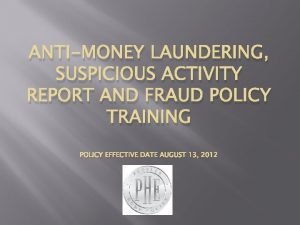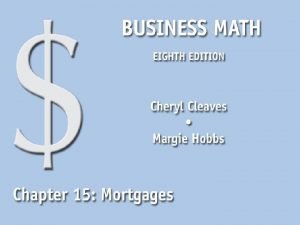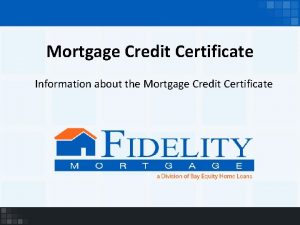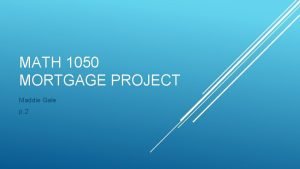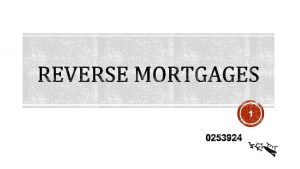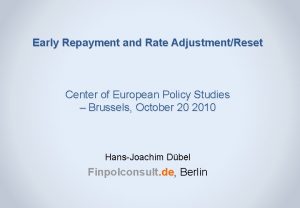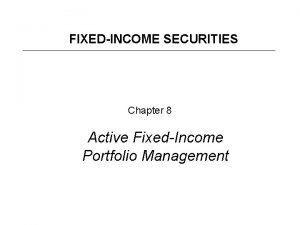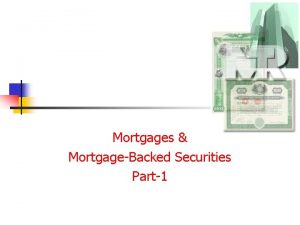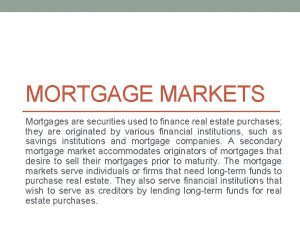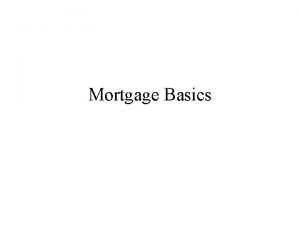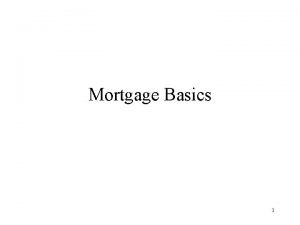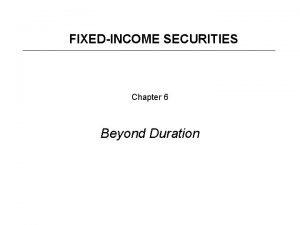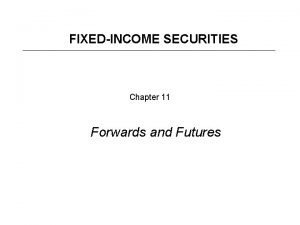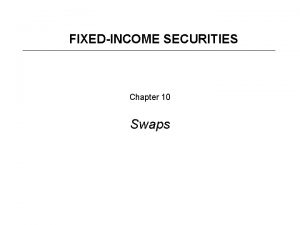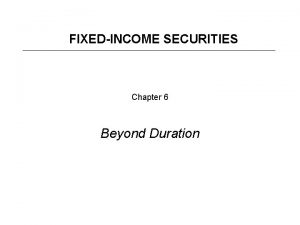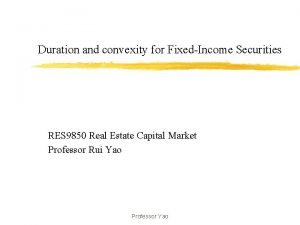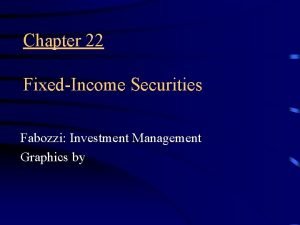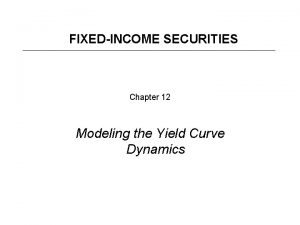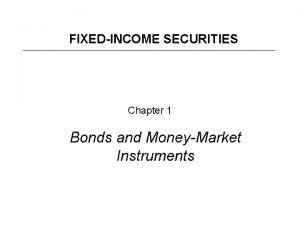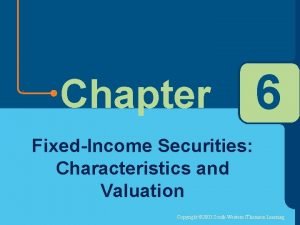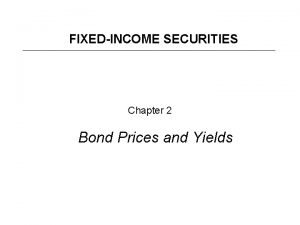FixedIncome securities Outline u Mortgages Types u Mortgage































- Slides: 31

Fixed-Income securities

Outline u Mortgages Types u Mortgage Risk u u The Mortgage Backed Securities Market History u Types of Securities u

Introduction A mortgage is a loan with real estate as collateral. The lender, called the mortgage originator, often charges points as a fee for preparing and placing the mortgage. It is quite common for the lender to sell the mortgage to another party.

Mortgages: Types u A fixed rate mortgage is one with payments based on a set interest rate that does not change. u An adjustable rate mortgage (ARM), also called a variable rate mortgage, has an interest rate that moves with some market interest rate, such as the Treasury bill rate. u Most ARMS have an annual reset to the interest rate. Many also have either a cap or a floor on the interest rate.

Mortgage Risk u Default risk is the risk that the borrower is unable or unwilling to repay the debt as agreed. u Interest rate risk is the risk that the general level of interest rates rises, such that the value of the mortgage’s cash flow stream declines. u Prepayment risk is the risk of an early payment of the original mortgage, such as when the home is sold or when the mortgage is refinanced at a lower rate.

The Mortgage Backed Securities Market u The Federal National Mortgage Association (Fannie Mae), the Government National Mortgage Association (Ginnie Mae), & the Federal Home Loan Mortgage Corporation (Freddie Mac) support the US mortgage market by providing liquidity, buying conforming mortgages from banks across the country for resale elsewhere. u The term mortgage-backed securities refers to all products based on mortgage loans.

Types of Securities u A pass-through security is a share of a pool of mortgages. Individual Mortgages Mortgage Pool Pass Through Security u The holders receive a monthly check for their portion of the scheduled principal and interest payments, plus their share of any prepayments that may occur.

Types of Securities w Pass-through securities may be issued and guaranteed by a government agency, or they may be private label. w Two types of derivative securities that spring from pass-through securities are collateralized mortgage obligations and stripped mortgage-backed securities.

Mortgage-Backed Bonds A Mortgage-Backed Bond is a bond backed by mortgages, with fixed interest rate and specific maturity u The bond is “overcollateralized” 125% or higher to insure that the income from mortgages will be sufficient to pay interest on the bonds and to repay principal at maturity u. Most bonds are rated and insured u

Types of Securities u u u A collateralized mortgage obligation (CMO) is a debt security backed by a pool of mortgages and structured to transfer prepayment or interest rate risk from one group of security holders to another Like Pass-Troughs it’s pay through security in that all interest and prepayments flow to investors A given pool of mortgages backs two or more classes of securities called tranches, with different maturities and risk/rating

Types of Securities Collateralized Mortgage Obligation Individual Mortgages Mortgage Pool A Tranche B Tranche C Tranche Other Tranches

Types of Securities u With a sequential pay CMO, all the tranche holders receive monthly interest payments based on the principal amount outstanding in their tranche. u All principal payments go to the A tranche until the A tranche principal is completely returned. Only then will the investors in the next tranche begin to receive principal.

Types of Securities u There are two types of stripped mortgage backed securities, or strips. Individual Mortgages Mortgage Pool Interest Only Security u Principal Only Security All the interest goes to the interest only (IO) security holders, while the entire principal goes to the principal only (PO) holders.

Considerations in Pricing Mortgage Backed Securities u The price risk of a MBS comes from the uncertainty about the timing of cash flows. u Prepayments can affect the realized return on a M BS substantially. u The offering memorandum for a M BS will state the assumptions used in estimating cash flows from the mortgage pool. u A benchmark assumption for the rate of mortgage prepayment is offered by the Public Securities Association (PSA).

The Risk of Collateralized Mortgage Obligations u Declining interest rates will increase the value of a cash flow stream and will lead to prepayments. u If a mortgage pool sells at a discount, prepayments will increase the value of each of the tranches, with the higher duration tranches benefiting the most. u If the pool sells at a premium, then prepayments will reduce everyone’s yield, with the effect most pronounced for the holders of the longer duration tranches.

The Risk of Stripped Mortgage Backed Securities u Prepayment has different consequences for IO and PO strips. An extension of the mortgage decreases the value of the principal payments but increases the value of the interest payments. u Declining interest rates will increase the value of a series of known cash flows, as well as the likelihood of prepayment. Normally, the prepayment effect overwhelms the interest rate effect.

FIXED INCOME CONCEPTS

Key Features of a Bond w Par value – face amount of the bond, which is paid at maturity (assume $1, 000). w Coupon interest rate – stated interest rate (generally fixed) paid by the issuer. Multiply by par to get dollar payment of interest. w Maturity date – years until the bond must be repaid. w Issue date – when the bond was issued. w Yield to maturity - rate of return earned on a bond held until maturity (also called the “promised yield”) w Some bonds are callable w Call provision: Allows issuer to refund the bond issue if rates decline (helps the issuer, but hurts the investor)

What is the value of a 10 -year, 10% annual coupon bond, if r d (discount rate)= 10%? 0 1 2 rd VB = ? n . . . 100 100 + 1, 000

Fixed Income Security Risk w Default risk, or credit risk, is the possibility that a borrower will be unable to repay principal and interest as agreed upon in the loan document. w Reinvestment rate risk refers to the possibility that the cash coupons received will be reinvested at a rate different from the bond’s stated rate. w Interest rate risk refers to the chance of loss because of adverse movements in the general level of interest rates.

What is the Yield-to-Maturity or cost of debt capital? w A discount rate (rd )/cost of debt capital and the expected return for the debt holder if the investor holds the bond until the maturity rd = r* + IP + MRP + DRP + LP r* = real risk free rate IP = inflation premium (rate) MRP = maturity risk premium DRP = credit risk premium LP = liquidity premium

What is interest rate (or price) risk? w Interest rate risk is the concern that rising rd will cause the value of a bond to fall. % change +4. 8% -4. 4% 1 yr $1, 048 $1, 000 $956 rd 5% 10% 15% 10 yr $1, 386 $1, 000 $749 % change +38. 6% -25. 1% The 10 -year bond is more sensitive to interest rate changes, and hence has more interest rate risk.

What is reinvestment rate risk? w Reinvestment rate risk is the concern that kd will fall, and future CFs will have to be reinvested at lower rates, hence reducing income. EXAMPLE: Suppose you just won $1, 000 playing the lottery. You intend to invest the money and live off the interest. w If you choose to invest in series of 1 -year bonds, that pay a 8% coupon you receive $80, 000 in income and have $1, 000 to reinvest. But, if 1 -year rates fall to 3%, your annual income would fall to $30, 000. w If you choose a 30 -year bond that pay a 10 % coupon you receive $100, 000 in income; you can lock in a 10% interest rate, and $100, 000 annual income for 30 years

Interest Rate Risk : Malkiel’s Theorems w Malkiel’s theorems are a set of relationships among bond prices, time to maturity, and interest rates. w Theorem One : Bond prices move inversely with yields. w Theorem Two : Long-term bonds have more risk. w Theorem Three : Higher coupon bonds have less risk.

Interest Rate Risk : Malkiel’s Theorems w Bond A : matures in 8 years, 9. 5% coupon Bond B : matures in 15 years, 11% coupon Which price will rise more if interest rates fall? w Apparent contradictions can be reconciled by computing a statistic called duration.

Duration u For a noncallable security, duration is the weighted average time until a bond’s cash flows are received. w Duration is not limited to bond analysis. It can be determined for any cash flow stream. w Duration is a direct measure of interest rate risk. The higher it is, the higher is the risk.

Duration Measures w Macaulay duration is the time-value-of-moneyweighted, average number of years necessary to recover the initial cost of the security. where D = duration Ct = cast flow at time t R = yield to maturity (per period) P = current price of bond N = number of periods until maturity t = period in which cash flow is received

Duration Measures w Modified duration measures the percentage change in bond value associated with a one -point change in interest rates.

price Problems with Duration u The bond price - bond yield relationship is not linear. yield to maturity w Graphically, duration is the tangent to the current point on the price-yield curve. Its absolute value declines as yield to maturity rises. w Duration is a first derivative statistic. Hence, when the change is large, estimates made using the derivative alone will contain errors.

Convexity w Convexity measures the difference between the actual price and that predicted by duration, i. e. the inaccuracy of duration. w The more convex the bond price-YTM curve, the greater is the convexity.

bond price Using Convexity yield to maturity w No matter what happens to interest rates, the bond with the greater convexity fares better. It dominates the competing investment.
 Mortgage backed securities diagram
Mortgage backed securities diagram Montana board of housing
Montana board of housing Types of equity securities
Types of equity securities Examples of quote sandwiches
Examples of quote sandwiches Reverse mortgage solutions reo properties
Reverse mortgage solutions reo properties Angel oak ms
Angel oak ms Usaa home loan pre approval
Usaa home loan pre approval Nmdb
Nmdb The hong kong mortgage corporation limited
The hong kong mortgage corporation limited Paul allen mortgage fraud
Paul allen mortgage fraud Primary vs secondary mortgage market
Primary vs secondary mortgage market Difference between hypothecation and mortgage
Difference between hypothecation and mortgage Mortgage brokers arkell
Mortgage brokers arkell Approved mortgage solutions
Approved mortgage solutions Debentures accounting
Debentures accounting 7-3 mortgage application process
7-3 mortgage application process Legal and general surveyors
Legal and general surveyors Home loan absa
Home loan absa Gpam mortgage loan
Gpam mortgage loan Powerhouse mortgage solutions
Powerhouse mortgage solutions Highland commercial mortgage
Highland commercial mortgage Mortgage chunking definition
Mortgage chunking definition Rafiq's monthly mortgage payment
Rafiq's monthly mortgage payment Mortgage in suncrest
Mortgage in suncrest Chfainfo.your mortgage online.com
Chfainfo.your mortgage online.com Math 1050 mortgage project
Math 1050 mortgage project Townsend mortgage company excel
Townsend mortgage company excel Deephaven mortgage reviews
Deephaven mortgage reviews Deephaven mortgage reviews
Deephaven mortgage reviews Prospect mortgage
Prospect mortgage Pwsb mortgage rates
Pwsb mortgage rates Huecu mortgage rates
Huecu mortgage rates
